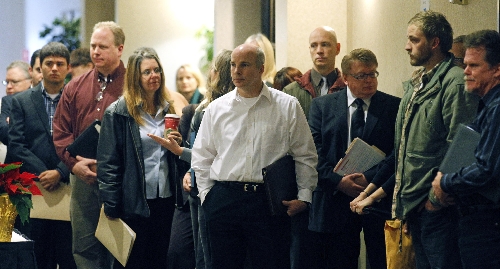Local economist sees good news in jobs report
The unemployment rate, which has refused to budge from the 9 percent neighborhood for two and a half frustrating years, fell sharply in November, driven in part by small businesses that finally see reason to hope and hire.
Economists say there is a long way to go, but they liked what they saw.
The rate fell to 8.6 percent, the lowest since March 2009, two months after President Barack Obama took office. Unemployment passed 9 percent that spring and had stayed there or higher for all but two months since then.
The country added 120,000 jobs in November, the Labor Department said Friday. Private employers added 140,000 jobs, while governments cut 20,000.
The economy has generated 100,000 or more jobs five months in a row -- the first time that has happened since April 2006, well before the Great Recession.
"Something good is stirring in the U.S. economy," Ian Shepherdson, an economist at High Frequency Economics, said in a note to clients.
Observers in Southern Nevada also saw positive signs in the report.
Jeremy Aguero, a principal in local research and consulting firm Applied Analysis, said job creation didn't quite match population growth, and he noted that some of the unemployment decline came from discouraged workers dropping out of the job hunt.
"But we're creating jobs where we weren't a year ago," Aguero said. "While it's not enough jobs, it's better than losing jobs. The fact that the unemployment rate is dropping, particularly going into the holiday season, is pretty darn compelling. It's exactly what we want to see."
National unemployment is important to Nevada because the state relies on discretionary spending to power its tourism- and retail-heavy economy.
NEVADA ANALYSIS HOPEFUL
The state's November jobless rate won't be out until Dec. 19, but Aguero said he expects the report to show trends similar to what the nation is experiencing: a little job growth in already-improving sectors with some continued softness in workforce participation.
Unemployment was at 13.4 percent statewide and 13.1 percent in Las Vegas in October, down from nearly 15 percent a year earlier, according to the state Department of Employment, Training and Rehabilitation.
Nevada added about 15,000 jobs year over year in October, many of them in leisure and hospitality, professional and business services and health care and education.
But the state also saw its total workforce drop 1.7 percent year over year, to 1.32 million people. The labor force fell 1 percent in Las Vegas, to 945,700 people.
Labor departments don't count workers among the unemployed once they quit seeking jobs, so a falloff in the labor pool can push down unemployment rates. Economists would rather see unemployment drop because of job growth.
Aguero said the local labor force seems to be stabilizing, with indicators showing equilibrium between arriving and departing residents. Driver's license turn-ins from motorists moving from other states are up dramatically in Clark County in 2011. But the number of kids who left the Clark County School District after school started -- an indication of outmigration -- is up, too.
Also, the number of people actively seeking jobs is creeping up in Nevada, Aguero added.
Thanks to better job growth nationally, job creation should pick up in Nevada in coming months as well, Aguero said. Better hiring will mean more retail spending this holiday season, which in turn means even more job growth. Applied Analysis expects an increase of more than 6 percent in Nevada's taxable retail sales in 2011, powered partly by a big uptick in seasonal spending toward the end of the year.
"For so long, Nevada lagged behind the U.S. overall in terms of staying in the recession longer. The recession here was deeper than it was nationwide," Aguero said. "Now, Nevada is improving at a slow and steady pace. The fact that the nation as a whole is showing signs of improvement is only going to bode well for Nevada."
STOCK MARKET RESULTS FLAT
Friday's report didn't create big waves in the nation's markets.
The stock market rallied at the opening bell, after the report came out, but finished flat for the day. It was still up 787 points for the week. The only bigger point gain in a week was in October 2008, when stocks lurched higher and lower during the financial crisis.
The report showed that September and October were stronger months for the job market than first estimated. For four months in a row, the government has revised job growth figures higher for previous months.
September was revised up by 52,000 jobs, for a gain of 210,000. October was revised up by 20,000, for a gain of 100,000.
Unemployment peaked at 10.1 percent in October 2009, four months after the Great Recession ended. It dipped to 8.9 percent last February and 8.8 percent last March but otherwise was at or above 9 percent.
The rate fell not just because people found jobs. About 300,000 people simply gave up looking for work and were no longer counted as unemployed. People routinely enter and leave the workforce, though 300,000 is more than usual.
Obama, who faces a re-election vote in less than a year and a presidential campaign that will turn on the economy, seized on the decline to argue for expanding a cut in the tax that workers pay toward Social Security.
The tax cut affects 160 million Americans. It lowers a worker's Social Security tax by up to $2,136 a year. Someone earning $50,000 a year saves $1,000 with the tax cut. It will expire Dec. 31 unless Congress acts.

















